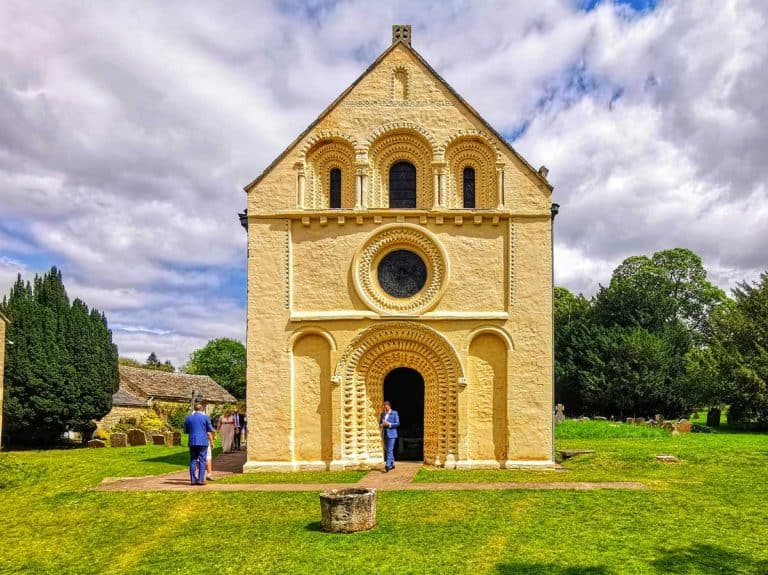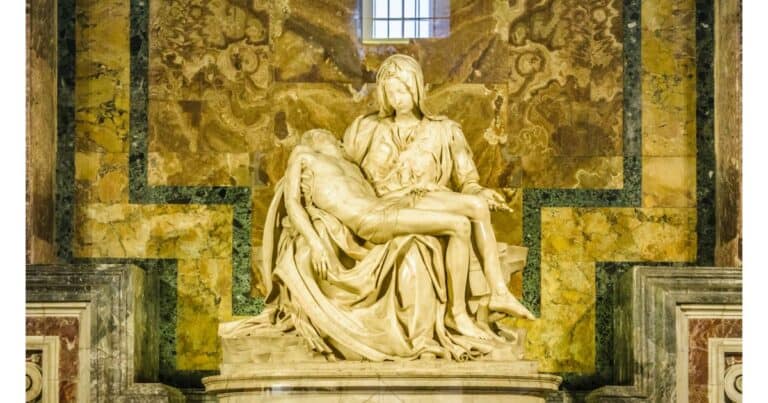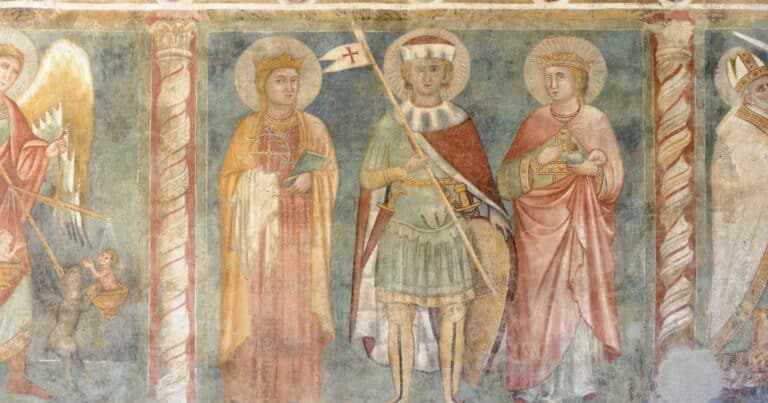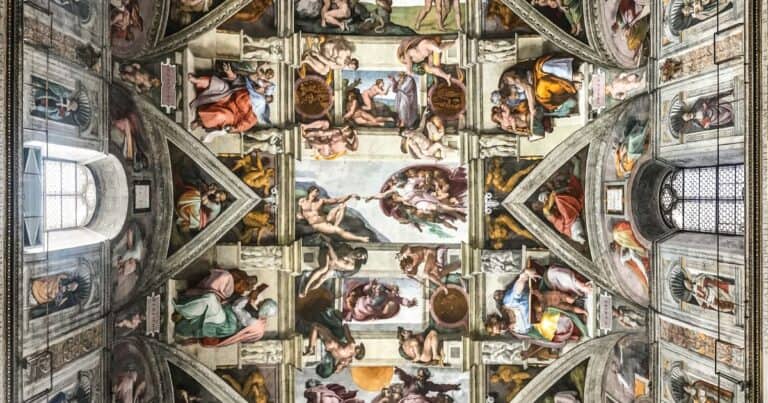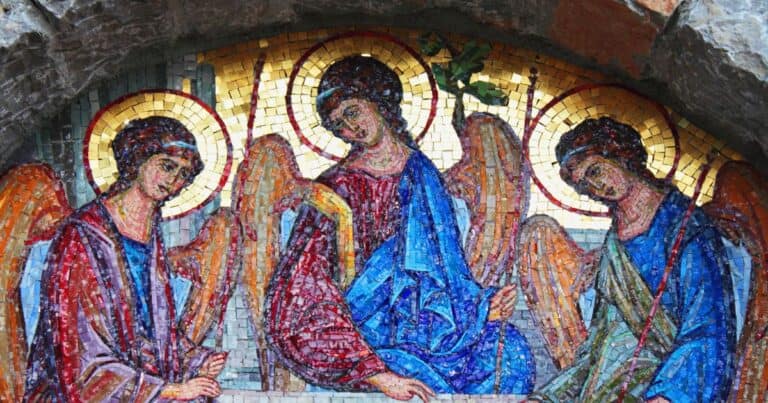Famous Christ Paintings: How Artists Have Portrayed the Savior Through the Ages
If you’ve ever found yourself captivated by the world of art, you might have noticed one figure that artists just can’t seem to resist – Christ. The story of Christ, steeped in divine mystery and profound teachings, has inspired artists and given us some of history’s most famous Christ paintings.
In this article, we’ll embark on an enlightening journey through the annals of art history, pausing to appreciate these iconic Christ paintings. We’ll delve into the narratives they portray, the artists who breathed life into them, and the historical and cultural contexts that shaped their creation.
The Role of Christ in Art
The role of Jesus in art extends beyond mere representation. It is a reflection of the diverse cultural, historical, and theological contexts in which these artworks were created. From the tranquil mosaics of the Byzantine era to the emotive masterpieces of the Baroque period, each depiction of Christ contributes to a rich tapestry of artistic interpretation.
These famous Christ paintings serve not only as testaments to the artists’ skill and creativity but also as historical documents that provide valuable insights into the evolving perceptions of Christ throughout the centuries.
Influence of Cultural Context on Depictions of Jesus
Now, you might be thinking, “Why does Jesus look different in every painting?” Well, that’s where culture steps in. Every artist paints Christ through the lens of their own culture, adding their unique spin to His depiction.
Early Christian art, for instance, often showed Christ as a shepherd or a young teacher, reflecting the societal norms of the time. As Christianity spread, so did these interpretations, resulting in a rich tapestry of famous Christ paintings we see today.
The Evolution of Christ’s Image in Art
From the youthful, beardless figure of early Christian art to the familiar bearded figure of the Renaissance, the depiction of Christ has evolved significantly over the centuries. But it’s not just about changing artistic styles. These shifts also reflect changing theological perspectives and societal attitudes.
So, next time you’re admiring famous Christ paintings, remember you’re not just looking at a work of art. You’re looking at a piece of history.
Famous Christ Paintings
Now, let’s get to the heart of the matter – the famous Christ paintings themselves. These aren’t just any paintings. They’re the crème de la crème, the ones that have stood the test of time, captivating audiences with their beauty and depth. Each one is a testament to the artist’s skill and the enduring allure of Christ as a subject of art.

“The Last Supper” by Leonardo da Vinci
Leonardo da Vinci’s “The Last Supper” is a masterclass in perspective, composition, and emotional storytelling. Da Vinci captures the pivotal moment when Christ reveals His impending betrayal, and the apostles’ reactions are a study of human emotion.
The painting is awash in drama and tension, as each apostle reacts uniquely to the news. The expressions on their faces range from shock and disbelief to anger and betrayal. The painting is a powerful reminder of the human capacity for both good and evil.
Jesus, rather than being a passive victim, willingly offers himself as a sacrifice for the salvation of others in the life to come, akin to the lamb sacrificed during Passover in ancient Hebrew tradition, writes Professor Paul Brians, Washington Statement University.
If you’re intrigued by da Vinci’s depiction and want to explore the original narrative that inspired this masterpiece, you can find the account of The Last Supper in the New Testament of the Bible. The event is described in all four Gospels:
- Matthew 26:17-30
- Mark 14:12-26
- Luke 22:7-23
- John 6:51-57

“The Sistine Madonna” by Raphael
The Sistine Madonna by Raphael is one of the most iconic paintings of the Madonna and Child. The painting depicts Mary with the Christ Child in her arms, surrounded by saints and angels. Raphael’s use of color and composition is masterful, creating a sense of divine elegance.
The painting’s sweetness and tenderness are balanced by its underlying seriousness as Mary gazes out at the viewer with a knowing expression. The Sistine Madonna is a masterpiece of Renaissance art, and it continues to inspire and awe viewers today.
The painting can be interpreted as a celebration of peace and faith and a representation of the Virgin Mary’s role as theotokos, or “bearer of God,” according to an article on the Ben Vaughn website. The painting has also been interpreted as a political statement, as it was commissioned by Pope Julius II, who was a powerful figure in the Catholic Church.
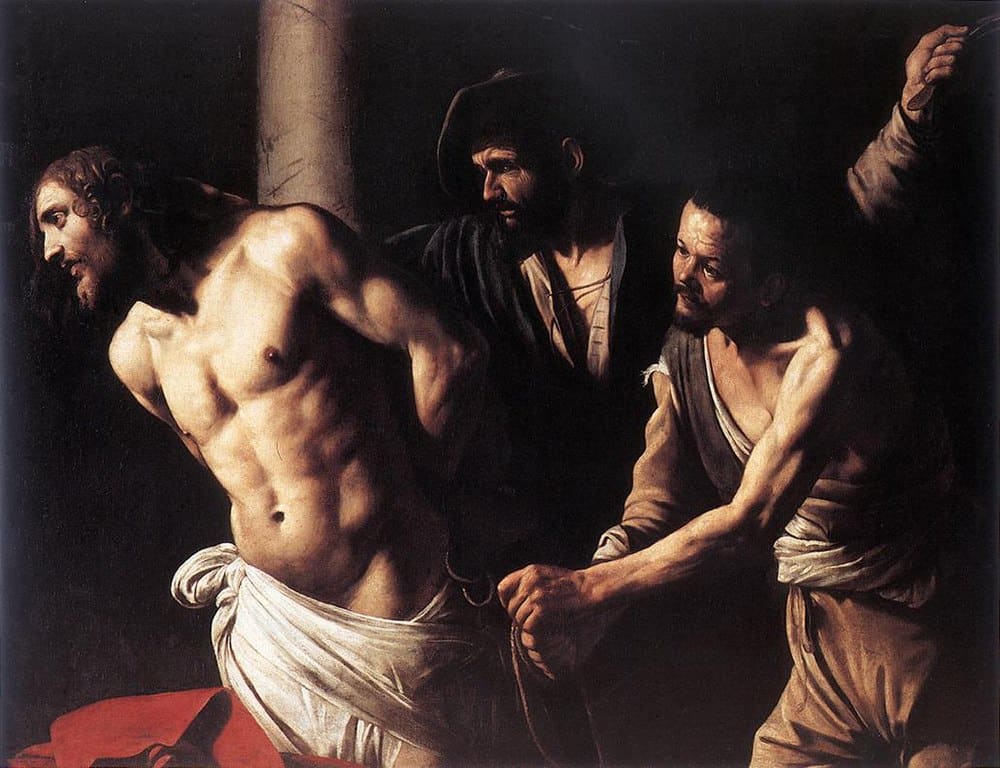
“Christ at the Column” by Caravaggio
As art historian John Varriano notes in his book “Caravaggio: The Art of Realism,” Caravaggio’s use of chiaroscuro creates a sense of immediacy and urgency, and the viewer is drawn into the scene, feeling the pain and humiliation that Christ is experiencing.
The painting is also exceptional for its realism. Varriano writes that Caravaggio did not shy away from depicting the physical suffering of Christ, and the viewer is confronted with the bloody wounds and bruised flesh of the Son of God. This realism is shocking and moving, and it underscores the brutality of Christ’s crucifixion.
Christ at the Column is one of Caravaggio’s most famous paintings, considered a masterpiece of Baroque art.
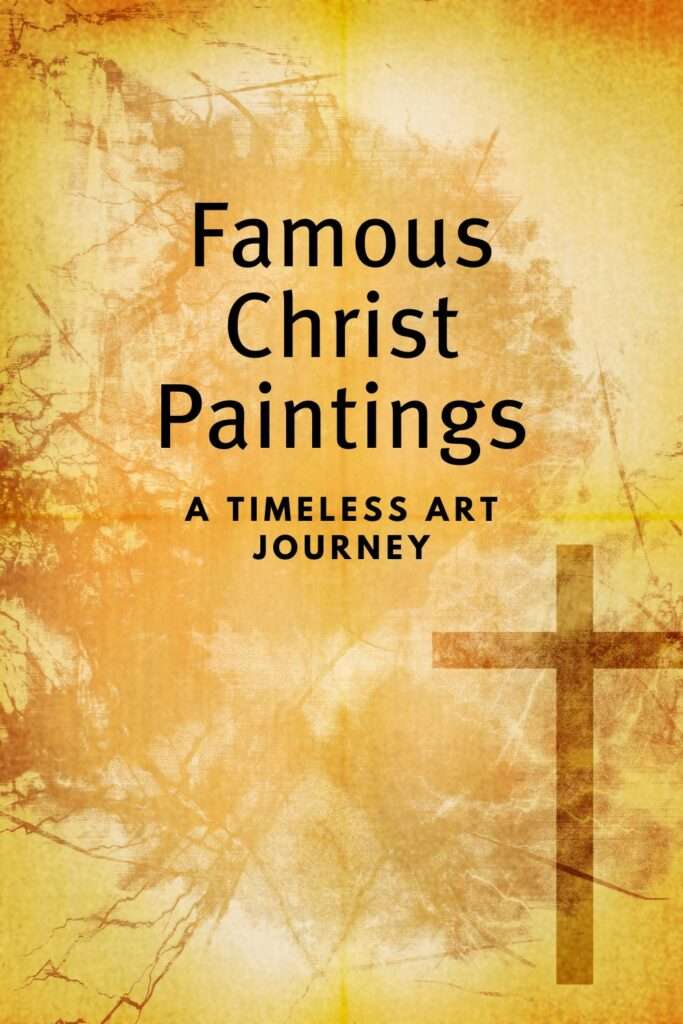
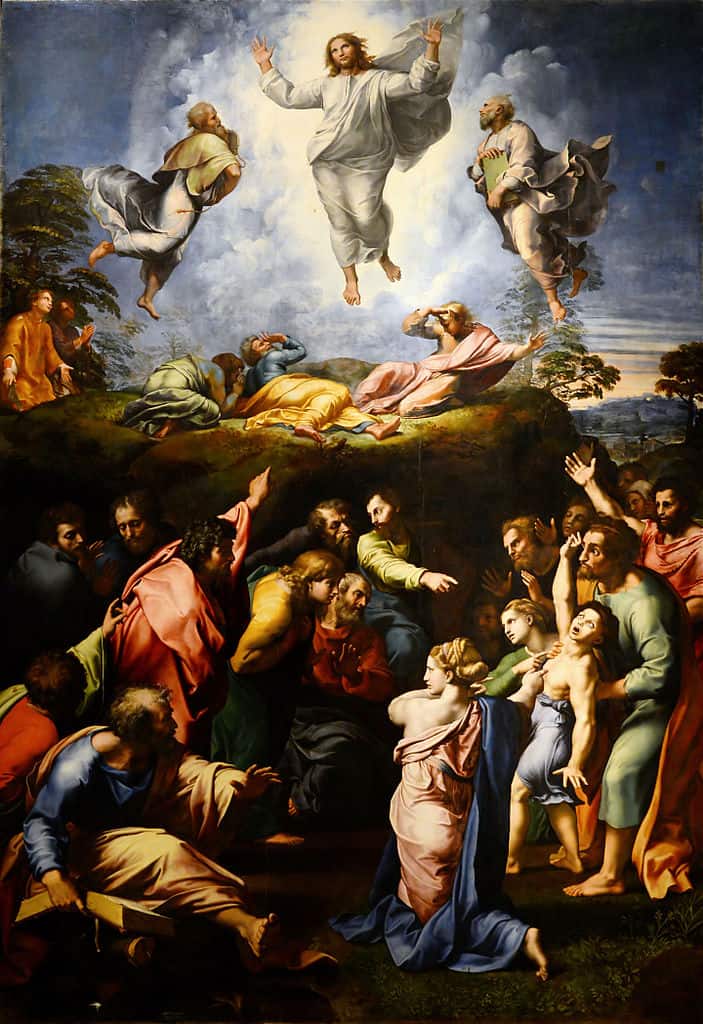
“The Transfiguration” by Raphael
Raphael’s The Transfiguration is a visual feast depicting Christ’s transfiguration on Mount Tabor. The painting is divided into two halves, with the upper half showing Christ transfigured in a radiant light, surrounded by Moses and Elijah. The lower half shows the apostles Peter, James, and John, who are witnessing the transfiguration.
Raphael’s use of light and color is masterful. The upper half of the painting is bathed in a golden light, while the lower half is in shadow. This creates a sense of contrast and drama, and it also helps to focus the viewer’s attention on the central figure of Christ.
The painting’s use of symbolism is particularly striking. The golden light in the upper half of the painting represents the divine, while the shadow in the lower half represents the human. The apostles in the lower half are kneeling in awe, and their faces are illuminated by the light from above. This suggests that they are beginning to understand the divinity of Christ.
You may also enjoy reading: Under the Divine Canopy: A Voyage Through Famous Christian Art
“Christ of Saint John of the Cross” by Salvador Dali
As we continue our journey, we encounter Salvador Dali’s “Christ of Saint John of the Cross.” This painting is a departure from traditional Christ depictions. Dali, known for his surrealistic style, offers a unique perspective of Christ’s crucifixion, viewed from above. This unconventional viewpoint results in a thought-provoking piece that challenges traditional norms and solidifies its place among famous Christ paintings.
The importance of “Christ of Saint John of the Cross” lies in its innovative approach to religious iconography. Dali’s painting is not just a depiction of Christ’s crucifixion, but a commentary on the nature of divine perspective and human understanding. The bird’s-eye view of Christ on the cross invites viewers to contemplate the event from a divine perspective, offering a fresh interpretation of a familiar narrative.
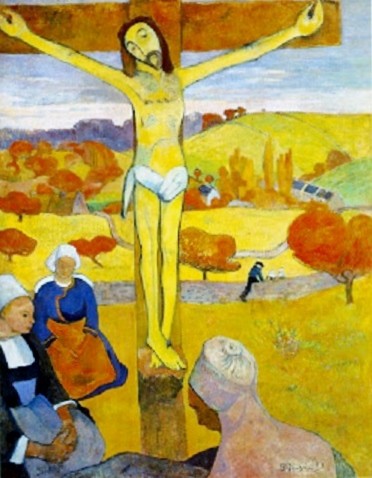
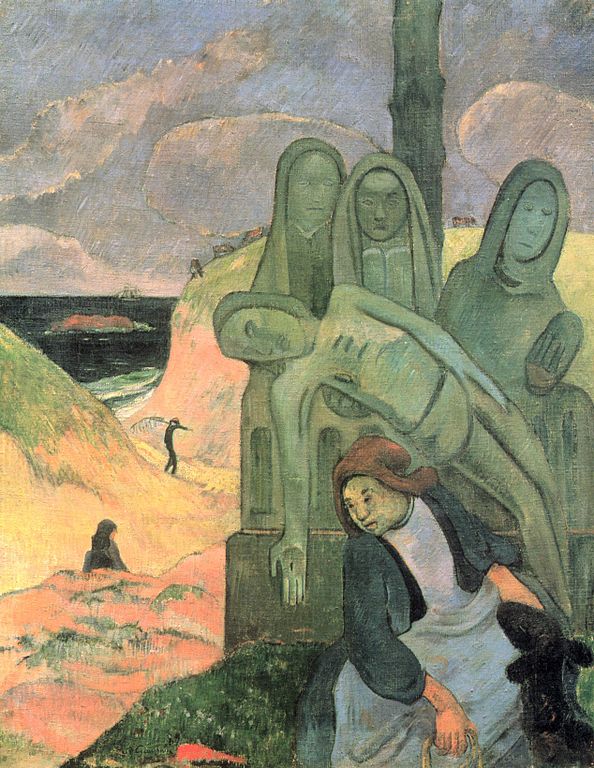
“The Yellow Christ” and “The Green Christ” by Paul Gauguin
As we delve further, we encounter Paul Gauguin’s “The Yellow Christ” and “The Green Christ.” Gauguin, celebrated for his audacious use of color, reimagines Christ in a new light, quite literally. His paintings, resplendent with vibrant hues and symbolic imagery, offer a refreshing reinterpretation of traditional depictions of Christ.
The significance of “The Yellow Christ” and “The Green Christ” lies in Gauguin’s innovative use of color to convey emotion and symbolism. Gauguin’s bold colors and simplified forms break away from the realistic depictions common in religious art, reflecting his search for spiritual truth and his desire to express the essence of the subjects rather than their physical appearance.
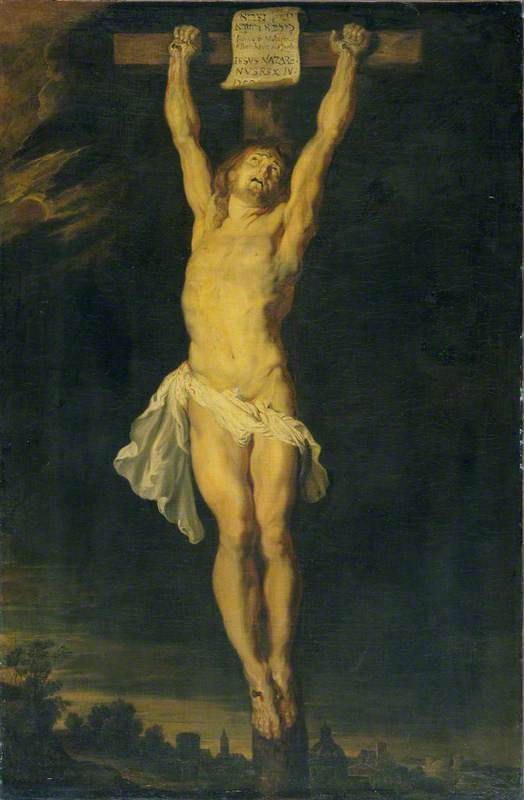
“The Crucifixion” by Peter Paul Rubens
“The Crucifixion” by Peter Paul Rubens. Rubens, a master of the Baroque style, depicts the crucifixion with dramatic intensity. The dynamic composition and vivid details make this painting a powerful representation of Christ’s sacrifice.
More than a depiction of Christ’s sacrifice, Rubens’ “The Crucifixion” is a testament to the emotional depth and dramatic intensity that the Baroque style is known.
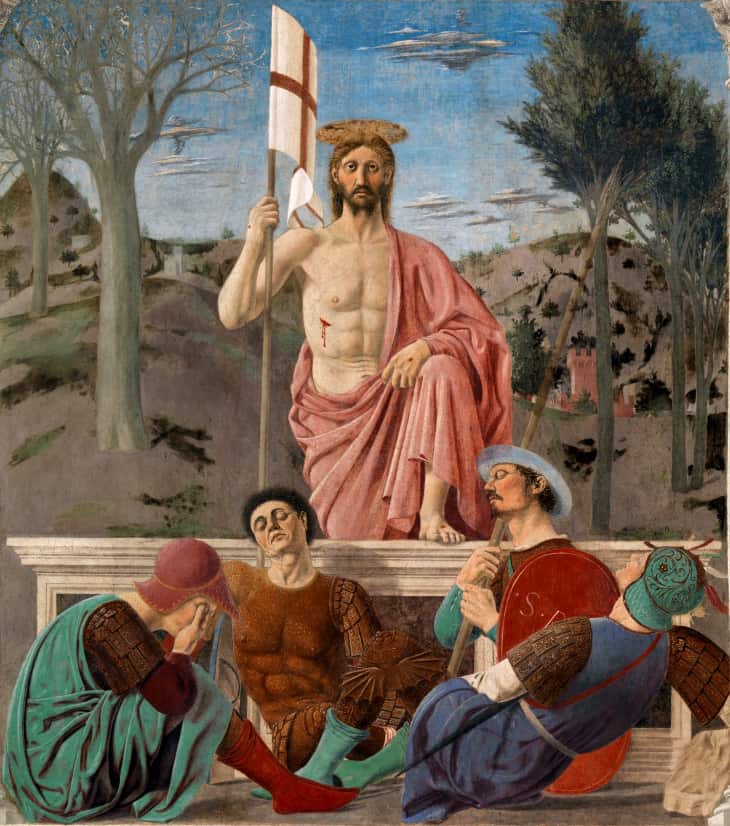
“The Resurrection” by Piero della Francesca
Piero della Francesca’s “The Resurrection” is another gem among famous Christ paintings. The painting, known for its serene composition and subtle use of color, depicts the moment of Christ’s resurrection, symbolizing hope and renewal. The painting’s tranquil composition and subtle use of color are characteristic of della Francesca’s style, which often emphasized clarity and simplicity.
The painting is a fresco, meaning it was painted directly onto the wall. This technique was common in the Renaissance, allowing artists to create large, detailed paintings that would be well-preserved over time.
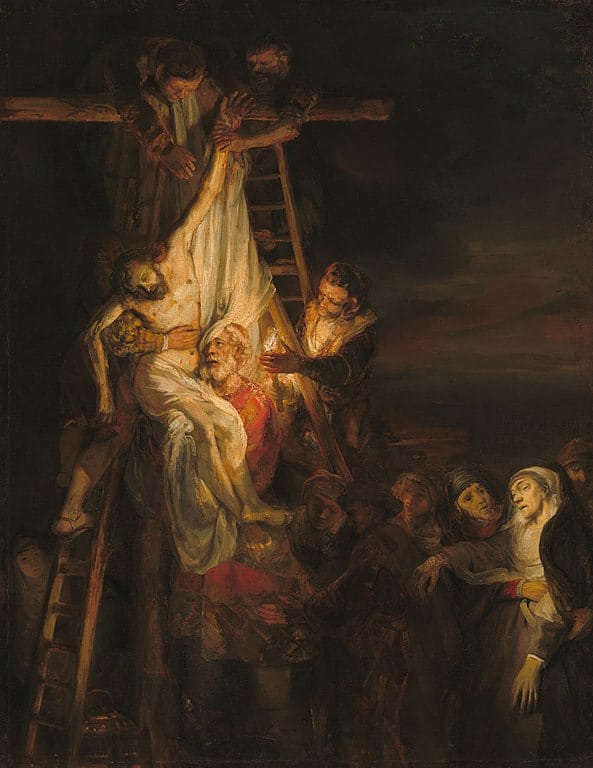
“The Descent from the Cross” by Rembrandt
Rembrandt’s “The Descent from the Cross” is a masterpiece of chiaroscuro. The painting depicts the sorrowful moment of Christ’s descent from the cross, with strong contrasts between light and dark creating a sense of volume and emotion. The figure of Christ is bathed in light, while the figures of the mourners are shrouded in shadow. This creates a stark contrast between Christ’s divinity and the humanity of those who are grieving his death.
The painting is also notable for its intricate detail. The artist has carefully rendered the folds of Christ’s clothing, the muscles of the men who are lifting him down from the cross, and the expressions of grief on the faces of the mourners. This level of detail allows the viewer to feel as if they are right there at the scene, witnessing the event themselves.
“The Descent from the Cross” is one of Rembrandt’s most famous paintings and is considered a masterpiece of Dutch Baroque art.
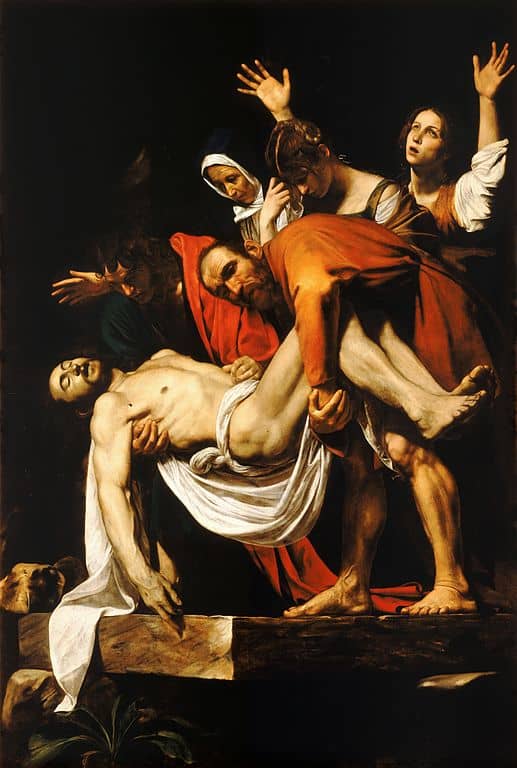
“The Entombment of Christ” by Caravaggio
Caravaggio’s “The Entombment of Christ,” renowned for his dramatic chiaroscuro technique, presents a moving scene of Christ’s burial. The painting, with its stark realism and emotional depth, is a fitting conclusion to our exploration of famous Christ paintings.
More than a poignant scene of Christ’s burial, Caravaggio’s “The Entombment of Christ” reflects Caravaggio’s innovative style and his ability to capture the emotional intensity of the scene.
Where to View These Famous Christ Paintings
If these famous Christ paintings have piqued your interest, you might be wondering where you can view them in person. Well, you’re in luck. These masterpieces are housed in some of the world’s most renowned museums and galleries. Here’s where you can find them:
- “The Last Supper” by Leonardo da Vinci: Convent of Santa Maria delle Grazie, Milan, Italy
- “The Sistine Madonna” by Raphael: Gemäldegalerie Alte Meister, Dresden, Germany
- “Christ at the Column” by Caravaggio: Musée des Beaux-Arts de Rouen, Rouen, France
- “The Transfiguration” by Raphael: Pinacoteca Vaticana, Vatican City
- “Christ of Saint John of the Cross” by Salvador Dali: Kelvingrove Art Gallery and Museum, Glasgow, Scotland
- “The Yellow Christ” by Paul Gauguin: National Gallery of Scotland, Edinburgh, Scotland
- “The Green Christ” by Paul Gauguin: Royal Museum of Fine Arts of Belgium in Brussels
- “The Crucifixion” by Peter Paul Rubens is currently owned by the Philadelphia Museum of Art and moves around for viewing to major museums around the world.
- “The Resurrection” by Piero della Francesca: Museo Civico, Sansepolcro, Italy
- “The Descent from the Cross” by Rembrandt: Hermitage Museum, St. Petersburg, Russia
Beyond Paintings: Christ in Sculpture and Architecture
While our journey so far has focused on famous Christ paintings, the depiction of Christ extends far beyond the canvas. Artists have been inspired to represent Christ’s figure in various mediums, each offering unique perspectives and interpretations. Two such mediums that have played a significant role in Christian art are sculpture and architecture.
Sculpture, with its three-dimensional form, offers a tangible representation of Christ. From the intricate carvings of medieval cathedrals to the grandeur of Renaissance marble statues, sculptures of Christ have been instrumental in visualizing the divine for the faithful.
One of the most renowned examples is Michelangelo’s “Pietà,” housed in St. Peter’s Basilica in Vatican City. This masterpiece captures the poignant moment of Mary cradling the lifeless body of Christ, showcasing the artist’s extraordinary skill and emotional depth. It was carved from a single block of marble and was completed in 1499 when Michelangelo was only 24 years old.
On the other hand, architecture provides a grand stage for the narrative of Christ’s life and teachings. Churches and cathedrals, adorned with biblical scenes and figures, serve as monumental testaments to Christ’s influence. The Basilica of the Sagrada Familia in Barcelona, designed by Antoni Gaudí, is a prime example. Its intricate facades depict scenes from Christ’s birth, life, and passion, making the entire building a canvas for the story of Christ.
So, while famous Christ paintings offer a wealth of insight into the depiction of Christ in art, it’s worth remembering that the story doesn’t end there. Sculpture and architecture provide additional layers of interpretation, enriching our understanding of Christ’s representation in art.
Christ in Non-Western Art Traditions
As we journey through the world of famous Christ paintings, it’s important to remember that the story of Christ isn’t confined to the Western world. Artists from diverse cultures and traditions have also been inspired to depict Christ, adding their unique perspectives to the rich tapestry of Christian art.
African Depictions of Jesus
In African art, depictions of Christ often reflect the local culture and traditions. Christ is portrayed with African features, and the artwork often incorporates local symbols and motifs. These depictions serve as a powerful reminder that the message of Christ transcends cultural and geographical boundaries.
Asian Depictions of Jesus
Similarly, in Asian art, Christ is depicted in a way that resonates with local cultural and spiritual traditions. From the serene Christ figures in Japanese Christian art to the vibrant depictions in Indian Christian communities, these artworks offer a fresh perspective on the figure of Christ.
Indigenous Depictions of Jesus
Indigenous artists have also contributed to the body of famous Christ paintings, infusing their artwork with their unique cultural symbolism and spirituality. These depictions of Christ often incorporate elements of nature and local spiritual beliefs, creating a fusion of Christian iconography and indigenous art.
Exploring these non-Western depictions of Christ broadens our understanding of Christian art and highlights the universal appeal of Christ’s message. It’s a testament to the power of art to transcend cultural and geographical boundaries, creating a diverse and inclusive narrative of Christ’s life and teachings.
Final Thoughts
As we draw our journey through the world of famous Christ paintings to a close, it’s clear that the figure of Christ has been a wellspring of inspiration for artists across the globe. From the masterpieces of the Renaissance to the provocative interpretations of modern art, each painting offers a unique perspective on Christ’s life, teachings, and divine persona.
But remember, these paintings are more than just beautiful works of art. They’re visual narratives, each telling its own version of the greatest story ever told. They reflect their creation’s cultural and historical context, offering insights into how perceptions of Christ have evolved over time. And they remind us that the story of Christ transcends cultural and geographical boundaries, resonating with people from all walks of life.
So, whether you’re an art enthusiast, a student of history, or someone seeking a deeper understanding of Christian iconography, I hope this exploration of famous Christ paintings has been as enlightening for you as it has been for me.
And remember, next time you find yourself standing in front of a painting of Christ, take a moment to appreciate the story it tells. You’ll be looking at a piece of history, a work of art, and a testament to the enduring allure of Christ in the world of art.
FAQs
As we wrap up our exploration of famous Christ paintings, you might have a few questions lingering in your mind. Don’t worry, you’re not alone. Here are some frequently asked questions that might help clear things up:
Why is Jesus often depicted in a certain way in art?
Well, the depiction of Jesus in art is influenced by various factors, including cultural context, historical period, and theological beliefs. Artists often use their work to convey a particular aspect of Christ’s life or teachings, resulting in diverse depictions.
How have depictions of Jesus changed over time?
Just like fashion trends, depictions of Jesus have evolved over time. Early Christian art often portrayed Christ as a shepherd or a young teacher, while later periods saw a shift towards a more familiar bearded figure. These changes reflect evolving artistic styles and shifting societal attitudes and theological perspectives.
What are some of the most famous paintings of Jesus?
Many famous Christ paintings have captivated audiences over the centuries. Some of the most renowned include “The Last Supper” by Leonardo da Vinci, “The Sistine Madonna” by Raphael, and “Christ of Saint John of the Cross” by Salvador Dali. These paintings offer a unique interpretation of Christ’s life and teachings.
Why are there controversial depictions of Christ in art?
Art often pushes boundaries, and depictions of Jesus are no exception. Some artists portray Jesus in ways that challenge traditional representations or explore controversial themes. While these depictions can be provocative, they also stimulate discussion and offer fresh perspectives on the figure of Christ.

Teresa Trumbly Lamsam, Ph.D., is an accomplished Social Scientist and Journalist. Passionate about establishing credibility in the digital realm, she champions transparent and trustworthy online content. She is dedicated to producing content that sparks curiosity and nourishes the heart and mind.



